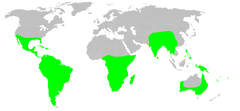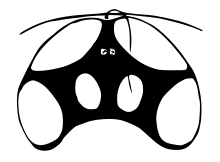Dipluridae
| Funnel-web tarantulas | |
|---|---|
 | |
| Linothele fallax | |
| Scientific classification | |
| Kingdom: | Animalia |
| Phylum: | Arthropoda |
| Subphylum: | Chelicerata |
| Class: | Arachnida |
| Order: | Araneae |
| Infraorder: | Mygalomorphae |
| Family: | Dipluridae Simon, 1889[2] |
| Genera | |
|
See text. | |
| Diversity[3] | |
| 24 genera, 185 species | |
 | |

The family Dipluridae, known as curtain-web spiders (or confusingly with other distantly related ones as funnel-web tarantulas[4]) are a group of spiders in the infraorder Mygalomorphae, that have two pairs of booklungs, and chelicerae (fangs) that move up and down in a stabbing motion. A number of genera, including that of the Sydney funnel-web spider (Atrax), used to be classified in this family but have now been moved to Hexathelidae.
Description
Dipluridae lack a rastellum (stout conical spines) on their chelicerae. Their carapace is characterized by the head region not being higher than the thoracic region. Their posterior median spinnerets (silk-extruding organs) are much shorter than their posterior lateral spinnerets, which have three segments, and are elongated (almost as long as their opisthosoma). Most of the species are medium to small-sized spiders, with some, such as the endangered Microhexura montivaga, as small as 3 mm, while others may measure about 15 mm.[5] The cave species Masteria caeca is eyeless.
Biology
Members of this family often build rather messy funnel-webs. Some build silk-lined burrows instead of webs (Diplura, Trechona, some Linothele sp.). They generally build their retreats in crevices in earthen banks, the bark of trees, under logs or in leaf litter.[5]
Distribution

Dipluridae occur almost worldwide in the tropics. Most are found in Central and South America, and many occur in the Australian region. Indothele is found in India and Sri Lanka. Ischnothele is a neotropical genus, but one species occurs only in India. Several genera are found in Africa, with Thelechoris also occurring in Madagascar. Leptothele and Phyxioschema suthepium are endemic to Thailand, with the other Phyxioschema species found in Central Asia. Masteria is widely distributed, with species found in places such as Central America, Fiji, the Philippines, Queensland and New Guinea.[6]
The common genus in the United States is Euagrus, which builds its webs under stones in wet canyons. It is abundant in such areas as the Chiricahua Mountains of Arizona.
Diplurids can be very common in banks and road cuts, such as in Trinidad.
Human interaction
There is no proper proof on the toxicity of their venom, but it is probably wise to avoid direct contact with the larger members (Diplura sp., Harmonicon sp., Linothele sp., and Trechona sp.).
The highly venomous genus Atrax used to be placed in this family, but is now in the Hexathelidae.
Genera
As of July 2018, the World Spider Catalog accepted the following extant (living) genera in the family Dipluridae:[2]
- Allothele Tucker, 1920
- Andethele Coyle, 1995
- Australothele Raven, 1984
- Caledothele Raven, 1991
- Carrai Raven, 1984
- Cethegus Thorell, 1881
- Chilehexops Coyle, 1986
- Diplura C. L. Koch, 1850
- Euagrus Ausserer, 1875
- Harmonicon F. O. Pickard-Cambridge, 1896
- Indothele Coyle, 1995
- Ischnothele Ausserer, 1875
- Lathrothele Benoit, 1965
- Leptothele Raven & Schwendinger, 1995
- Linothele Karsch, 1879
- Masteria L. Koch, 1873
- Microhexura Crosby & Bishop, 1925
- Namirea Raven, 1984
- Phyxioschema Simon, 1889
- Stenygrocercus Simon, 1892
- Siremata Passanha & Brescovit, 2018
- Striamea Raven, 1981
- Thelechoris Karsch, 1881
- Trechona C. L. Koch, 1850
- Troglodiplura Main, 1969
Extinct genera and species include:[7]
- †Clostes Menge, 1869 — fossil, Eocene Baltic amber
- †Clostes priscus (Menge, 1869)
- †Cretadiplura Selden, 2005 — fossil, Early Cretaceous[1]
- †Cretadiplura ceara Selden, 2005
- †Dinodiplura Selden, 2005 — fossil, Lower Cretaceous[1]
- †Dinodiplura ambulacra Selden, 2005
- †Seldischnoplura Raven, Jell & Knezour, 2015 — fossil, Early Cretaceous[1]
- †Seldischnoplura seldeni Raven, Jell & Knezour, 2015
- †Edwa Raven, Jell & Knezour, 2015 — fossil, Late Triassic (Norian) Blackstone Formation, Australia[1]
- †Edwa maryae Raven, Jell & Knezour, 2015
- † Phyxioschemoides Wunderlich, 2015 — fossil, Cretaceous Burmese amber[8]
- † Phyxioschemoides collembola Wunderlich, 2015
- † Cethegoides Wunderlich, 2017 — fossil, Cretaceous Burmese amber[9]
- † Cethegoides patricki Wunderlich, 2017
See also
References
- 1 2 3 4 5 Robert J. Raven, Peter A. Jell and Robert A. Knezour (2015). "Edwa maryae gen. et sp. nov. in the Norian Blackstone Formation of the Ipswich Basin—the first Triassic spider (Mygalomorphae) from Australia". Alcheringa: An Australasian Journal of Palaeontology. 39 (2): 259–263. doi:10.1080/03115518.2015.993300.
- 1 2 "Family: Dipluridae Simon, 1889", World Spider Catalog, Natural History Museum Bern, retrieved 2016-10-29
- ↑ "Currently valid spider genera and species", World Spider Catalog, Natural History Museum Bern, archived from the original on 2015-11-03, retrieved 2016-10-29
- ↑ Raven, R.J. (1985). "The spider Infraorder Mygalomorphae (Araneae): cladistics and systematics". Bulletin of the American Museum of Natural History. 182: 1–180.
- 1 2 Murphy & Murphy 2000
- ↑ Platnick 2008
- ↑ Dunlop, J.A.; Penney, D. & Jekel, D. (2017), "A summary list of fossil spiders and their relatives, version 18.0" (PDF), World Spider Catalog, Natural History Museum Bern, retrieved 2017-07-08
- ↑ Jörg Wunderlich (2015). "On the evolution and the classification of spiders, the Mesozoic spider faunas, and descriptions of new Cretaceous taxa mainly in amber from Myanmar (Burma) (Arachnida: Araneae)". In Jörg Wunderlich. Beiträge zur Araneologie, 9: Mesozoic spiders and other fossil arachnids. pp. 21–408.
- ↑ Jörg Wunderlich (2017). "New and rare fossil spiders (Araneae) in mid Cretaceous amber from Myanmar (Burma), including the description of new extinct families of the suborders Mesothelae and Opisthothelae as well as notes on the taxonomy, the evolution and the biogeography of the Mesothelae". In Jörg Wunderlich. Beiträge zur Araneologie, 10. pp. 72–279.
- Murphy, Frances & Murphy, John (2000): An Introduction to the Spiders of South East Asia. Malaysian Nature Society, Kuala Lumpur.
Further reading
- Chickering, A. M. (1964): Two new species of the genus Accola (Araneae, Dipluridae). Psyche 71: 174-180. PDF
- Coyle, F. A. (1986): Chilehexops, a new funnelweb mygalomorph spider genus from Chile (Araneae, Dipluridae). Am. Mus. Novit. 2860: 1-10. PDF
- Goloboff, Pablo A. (1994): Linothele cavicola, a new Diplurinae spider (Araneae, Dipluridae) from the caves in Ecuador. J. Arachnol. 22: 70-72. PDF
- Selden, P.A., da Costa Casado, F. & Vianna Mesquita, M. (2005): Mygalomorph spiders (Araneae: Dipluridae) from the Lower Cretaceous Crato Lagerstätte, Araripe Basin, North-east Brazil. Palaeontology 49(4): 817-826. doi:10.1111/j.1475-4983.2006.00561.x
External links
| Wikispecies has information related to Dipluridae |
| Wikimedia Commons has media related to Dipluridae. |
- Taxonomy, housing and captive breeding of Dipluridae sp. including key to all genera